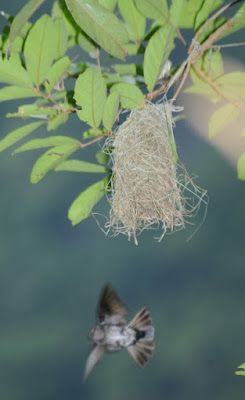Long-tailed Macaques (Macaca fascicularis) are urban animals in Malaysia, and around Connie's they made frequent use of the power lines.
In a nearby orchard we found a number of cuckoos, birds Connie takes a particular interest in, including a life bird for me, the Banded Bay Cuckoo (Cacomantis sonnerati). I was unable to get a decent shot of it, though, so you will have to settle for an easier species, the Green-billed Malkoha (Phaenicophaeus tristis). Malkohas are cuckoos, too, but (unlike the Banded Bay and its relatives) build their own nests.
A little clump of trees by a pond held a Blue-eared Kingfisher (Alcedo meninting)...
An Ashy Tailorbird (Orthotomus ruficeps), a common suburban species...
And the graceful little nest of a Pied Fantail (Rhipidura javanica), with the bird in residence. The "tail" of material hanging from the bottom of the cup is a typical feature of fantail nests; it may mislead predators into mistaking the nest for a bit of loose vegetation.
Perhaps the fantail was sitting on a second clutch, because it certainly had at least one nearly-grown young to attend to.
Connie showed us one particularly fascinating bit of bird behavior. Glossy Swiftlets (Collocalia esculenta) do not make their nests out of saliva as the various edible-nest swiftlets do but must construct them in the standard manner. An unfinished (and perhaps abandoned) nest of a Baya Weaver (Ploceus philippinus) provided them with a ready-made supply of construction material, and the birds were quite happy to plunder it.
Since swiftlets are incapable of perching on a twig, the swiftlets had to resort to a complicated series of acrobatic manouevres to carry out their thievery.
More birds: a White-rumped Shama (Copsychus malabaricus) postures on the roadway. Shamas are beautiful birds and great songsters (unfortunately for them, as they are increasingly poached for the cage-bird trade), but they can be shy and hard to see, so I was glad to get a few quick snaps of this bird.
Though they are abundant birds in China and other parts of their extensive range, Long-tailed Shrikes (Lanius schach) are rather rare in Malaysia (we have only recently started seeing them around Kuching, for example). Perak is one of their strongholds.
The Common Iora (Aegithina tiphia), on the other hand, is abundant, particularly around mangroves and in other lowland areas. The coloration on this one seemed particularly rich, but then, it's an attractive species anyway.
There were dragonflies around, too: this one, perching gracefully at the end of a twig, is the brightest and most thoroughly red of the various red libellulids, the Scaarlet Skimmer (Crocothemis servilia). Notice the black line on the upper surface of the abdomen, and see here for other I.D. notes.
At first sight, this may look like yet another of my endless photos of Orthetrum sabina (see, for example, my previous posting) but it is, in fact, a quite different, smaller dragonfly: Diplacodes trivialis, either a female or a young male (adult males grow increasingly blue). I'm glad to see that even an odonate expert like C.Y. Choong found these two species confusing!
Neurothemis fluctuans is one of the commonest dragonflies in West Malaysia. These are males...































No comments:
Post a Comment